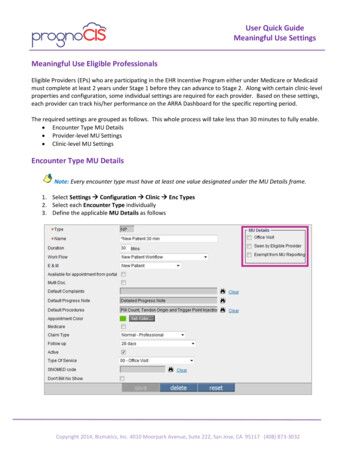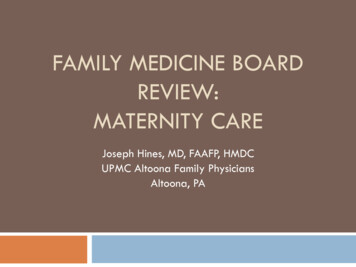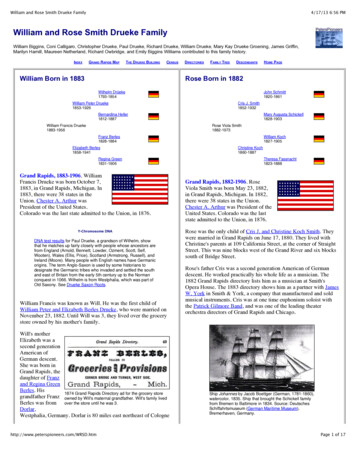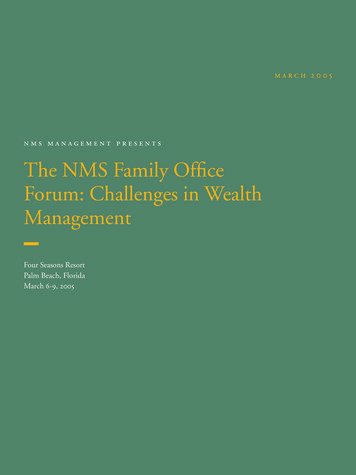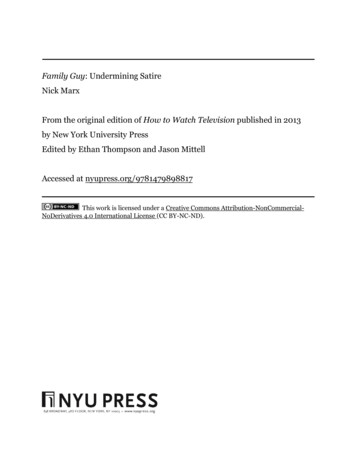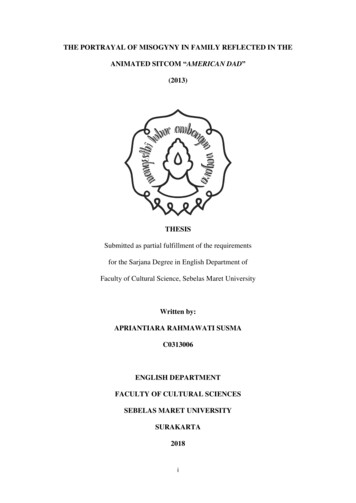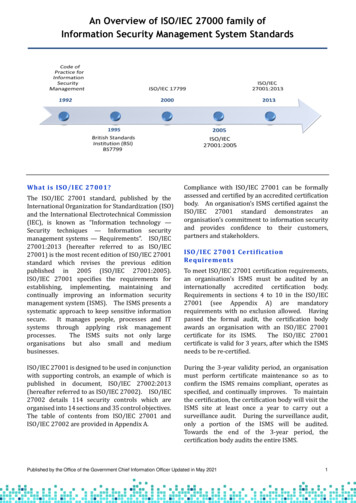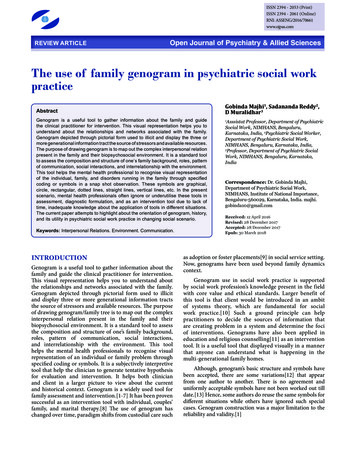
Transcription
ISSN 2394 - 2053 (Print)ISSN 2394 - 2061 (Online)RNI: ASSENG/2016/70661www.ojpas.comREVIEW ARTICLE Open Journal of Psychiatry & Allied SciencesThe use of family genogram in psychiatric social workpracticeGobinda Majhi1, Sadananda Reddy2,D Muralidhar3AbstractGenogram is a useful tool to gather information about the family and guidethe clinical practitioner for intervention. This visual representation helps you tounderstand about the relationships and networks associated with the family.Genogram depicted through pictorial form used to illicit and display the three ormore generational information tract the source of stressors and available resources.The purpose of drawing genogram is to map out the complex interpersonal relationpresent in the family and their biopsychosocial environment. It is a standard toolto assess the composition and structure of one’s family background, roles, patternof communication, social interactions, and interrelationship with the environment.This tool helps the mental health professional to recognise visual representationof the individual, family, and disorders running in the family through specifiedcoding or symbols in a snap shot observation. These symbols are graphical,circle, rectangular, dotted lines, straight lines, vertical lines, etc. In the presentscenario, mental health professionals often ignore or underutilise these tools inassessment, diagnostic formulation, and as an intervention tool due to lack oftime, inadequate knowledge about the application of tools in different situations.The current paper attempts to highlight about the orientation of genogram, history,and its utility in psychiatric social work practice in changing social scenario.Keywords: Interpersonal Relations. Environment. Communication.INTRODUCTIONGenogram is a useful tool to gather information about thefamily and guide the clinical practitioner for intervention.This visual representation helps you to understand aboutthe relationships and networks associated with the family.Genogram depicted through pictorial form used to illicitand display three or more generational information tractsthe source of stressors and available resources. The purposeof drawing genogram/family tree is to map out the complexinterpersonal relation present in the family and theirbiopsychosocial environment. It is a standard tool to assessthe composition and structure of one’s family background,roles, pattern of communication, social interactions,and interrelationship with the environment. This toolhelps the mental health professionals to recognise visualrepresentation of an individual or family problem throughspecified coding or symbols. It is a subjectively interpretivetool that help the clinician to generate tentative hypothesisfor evaluation and intervention. It helps both clinicianand client in a larger picture to view about the currentand historical context. Genogram is a widely used tool forfamily assessment and intervention.[1-7] It has been provensuccessful as an intervention tool with individual, couples’family, and marital therapy.[8] The use of genogram haschanged over time, paradigm shifts from custodial care suchAsssistat Professor, Department of PsychiatricSocial Work, NIMHANS, Bengaluru,Karnataka, India, 2Psychiatric Social Worker,Department of Psychiatric Social Work,NIMHANS, Bengaluru, Karnataka, India,3Professor, Department of Psychiatric SocialWork, NIMHANS, Bengaluru, Karnataka,India1Correspondence: Dr. Gobinda Majhi,Department of Psychiatric Social Work,NIMHANS, Institute of National Importance,Bengaluru-560029, Karnataka, India. majhi.gobinda10@gmail.comReceived: 12 April 2016Revised: 28 December 2017Accepted: 28 December 2017Epub: 30 March 2018as adoption or foster placements[9] in social service setting.Now, genograms have been used beyond family dynamicscontext.Genogram use in social work practice is supportedby social work profession’s knowledge present in the fieldwith core value and ethical standards. Larger benefit ofthis tool is that client would be introduced in an ambitof systems theory, which are fundamental for socialwork practice.[10] Such a ground principle can helppractitioners to decide the sources of information thatare creating problem in a system and determine the fociof interventions. Genograms have also been applied ineducation and religious counselling[11] as an interventiontool. It is a useful tool that displayed visually in a mannerthat anyone can understand what is happening in themulti-generational family homes.Although, genogram’s basic structure and symbols havebeen accepted, there are some variations[12] that appearfrom one author to another. There is no agreement anduniformly acceptable symbols have not been worked out tilldate.[13] Hence, some authors do reuse the same symbols fordifferent situations while others have ignored such specialcases. Genogram construction was a major limitation to thereliability and validity.[1]
Majhi et al.: Family genogramDEVELOPMENT ANDSTANDARDISATION OF GENOGRAMIn the 1960s, Murray Bowen and Jack Bradt, two familyoriented psychiatrists, first time employed family charts onblackboards or poster boards in their clinical and theoreticalwork with families.[14-16] Since then, no standardisedgenogram was made. Hence, considerable variations wereobserved in clinical practice as how to portray genogram inprofessional fields. In response to this diversity, McGoldrickand Gerson[8] formulated the first comprehensivestandardisation for constructing and interpreting genogramsbased on concepts articulated by Bowen and other systemstheorists. The information which they suggested to include inthe genogram are name, gender, age, and death of the familymembers, etc.Additional information may include education,occupation, chronic illnesses, social behaviours, nature offamily relationships, emotional relationships, and socialrelationships. Some genograms also include information ondisorders running in the family such as alcoholism, depression,diseases, alliances, and living situations, Genograms can varysignificantly because there is no limitation as to what type ofdata can be included.Basic genogram symbolsThe standard symbols most of the authors accepted arepresented in Figure 1.RULE TO BUILT GENOGRAMWhile drawing the family genogram, these are the basic rulesto be followed:i.Male should be drawn always at the left side whereasfemale is at the right position.ii. Assume male-female relationship to avoid the ambiguityrather male-male or female-female in drawing the family.iii. A spouse must be drawn in close to his/her partner andto maintain chronological order thereon for furtheronward partner.iv. According to birth order, children should be drawn leftto right in horizontal line.Standard genograms which are useful inpsychiatric social work practiceOver time, various standard genograms were developed; bothtraditional genograms as well as newly developed genogramsare useful for psychiatric social work practice. These arediscussed briefly for better understanding of usefulness forpsychiatric social work practice.1. Vertical genogramVertical genogram is like a conventional genogram; it is moreuseful in strategic and solution focused family therapy. Usuallyvertical genogram addresses the issues of couple’s problem, inwhich relationship of couples used to be delineated throughthe use of horizontal and vertical lines across the familycontext and vertically through the generations respectively.[8]The vertical lines connect generations’ parents with childrenFigure 1: Genogram symbols.via a dotted vertical line. While portraying vertical genogram,additional information can be depicted like separation,divorce, friendship, death, twin, abortion, strong ties betweenfamily members, and negative interactional patterns amongfamily members.[10]2. Horizontal genogramHorizontal genogram is also a part of traditional genogram.The significance of this genogram is that it would depict therelationship of same generation, such as aunty, uncle, cousin,etc. Horizontal genogram could also portray the extensionfrom where the basic family group branch out within aOJPAS 2018 Mar 30 [Epub ahead of print]
Majhi et al.: Family genogramgeneration, such as wife, sister, etc. Another example couldbe of polygamous families where one man lives with manywomen or vice versa. The horizontal lines place the familymembers of the same generation in same line. It usuallydenotes marital or common-law relationship. Chronologicalbirth order being followed from left to right while depictingthe children in the genogram.[10]3. Timeline genogramThe timeline genogram has been used to map traditionalgenogram information with temporal aspects of past events.[17]In timeline genogram, positive and negative timelines areintentionally drawn so that all family members could easilyunderstand the problems running in the family and how thoseproblems have been resolved by extending mutual support.This would give them opportunity to think in positive andconstructive manner. And also, it would ignite hope, trust, andboost the confidence among them. Further, it allows the familyto construct a perspective of normal response to stress, ratherthan viewing themselves as failures across time.[18]4. Colour-coded genogramColour-coded genogram has been used in all type ofsituations. However, Lewis[19] was first to use the colourcoded genogram in bulimic families. The colours used withbulimic families are the followingGreen: Overtly or covertly controlling.Blue: Peace at all costs, peace-keeper.Red: yorPurple: Difficulty with separation.intents to see the connectivity and affiliation of individualswith respect to religious preference, ties, and sentimentattached with the family.Social workers should explain the options to clients andallow them to select the colours of spiritually meaningfulevents and colour it according to their spiritual preferences.Also, help them guide to draw the family members spirituallyclosely associated among themselves.Spiritual conflict can be portrayed if any such kind ispresent in the family.[17] Most of the family members usespirituality as the technique of coping skills.[25]6. Sexual genogramHof and Berman[26] were the first to write about the sexualgenogram. The original sexual genogram is not structurallydifferent from a traditional genogram - both look at individualdata, transgenerational issues, and relationships.However, in current dynamic and complex society,translating and interpreting the sexual behaviour is acomplex phenomenon, socio-cultural factors play a vital rolewith regards to sexuality issues. Hof and Berman[26] havesuggested six contents that are to be addressed while assessingthe experience of sexuality and intimacy in the family oforigin both within and between generations. Those are:1) Overt/covert messages regarding sexuality/intimacy andmasculinity/femininity,2) Sexuality/intimacy communication and behaviours,3) Sexual secrets,4) Information still missing and how this might be gathered,5) Partner’s perception of each other’s sexual genograms, and6) Wishes about changing the individual’s/couple’s genogram.Complexities appear in modern sexual genogram symbologyand constructionYellow: Sexual issues.Black: Physical or mental health problem.Brown: Body image distortion or obsession.Orange: Alcohol or drug problem.Dotted black: Perfectionism.It is to explain that, once the family has drawn itsgenogram, the members are given a set of “magic markers”and a chart listing the items, as above. Thereafter, they wouldbe asked to add appropriate colours to the squares and circlesthat represent the family. All these colouring events wouldhappen with discussion, general agreement, and consensusamong family members. Lewis[19] quoted that colour-codinggenogram provides clinicians with another additional tool forassessment and treatment technique with new modality.5. Spiritual genogramFrame[20] created a spiritual genogram. It is an analogousof traditional genograms which provide three generationalvisual representation about spiritual affiliation informationof a family.[21] This genogram also displays the familycomposition and structure of at least three generations,[22-24]and depicts how spirituality passes on to next generation bydelineating with specific symbol. The spiritual genogramGender and gender expression are no longer as simplistic as itappears. Some of the complex phenomena including gender,sexual orientation and attraction, relationship lines, sexualcommunication and environment no longer get a generalconsensus with respect to sexual symbology for genogram.Following are the complexities with respect to symbologythat needs to be developed and allotted in simplified andacceptable manner for clinical and therapeutic purpose for allprofessions:i.ii.iii.iv.Transgender individuals,Transgender male to female,Transgender female to male,Plans for sex reassignment surgery (SRS), or completedSRS,v. Cross-dressing (dressing as opposite gender occasionally),vi. People who live cross-gender (no intent to have SRS, butliving and passing as preferred gender), andvii. Drag kings/drag queens (people who dress as a caricatureof the opposite gender often for entertainment).“Gender queer,” which can include:i.ii.Bigender/pangender (identifying as both man andwoman),Genderless/agender (neither man nor woman),OJPAS 2018 Mar 30 [Epub ahead of print]
Majhi et al.: Family genogramiii. Genderfluid (moving between genders),iv. Third gender or other-gendered (e.g. hijras in India).[27]7. Military genogramWeiss and colleagues[28] developed the military genogram.It is basically drawn for the purpose of assisting militarypersonnel and their family in recognising intergenerationalpatterns, both barriers and strengths present in the family.Unlike civilian family, military family represents a uniqueculture that emphasises the adherence to specific guidelineof conduct. Military familie
30.03.2018 · The spiritual genogram intents to see the connectivity and affiliation of individuals with respect to religious preference, ties, and sentiment attached with the family. Social workers should explain the options to clients and allow them to select the colours of spiritually meaningful events and colour it according to their spiritual preferences.


